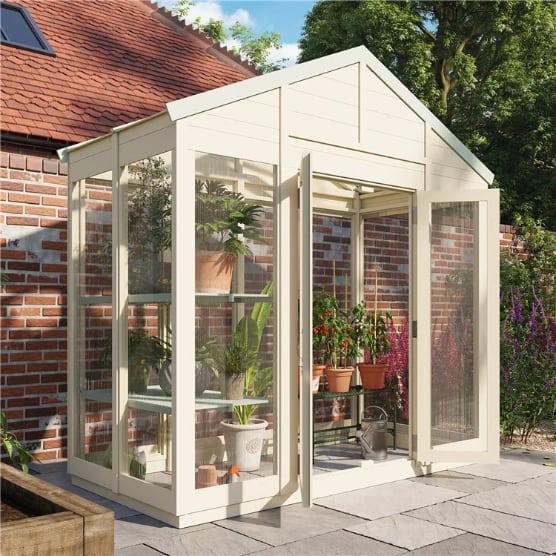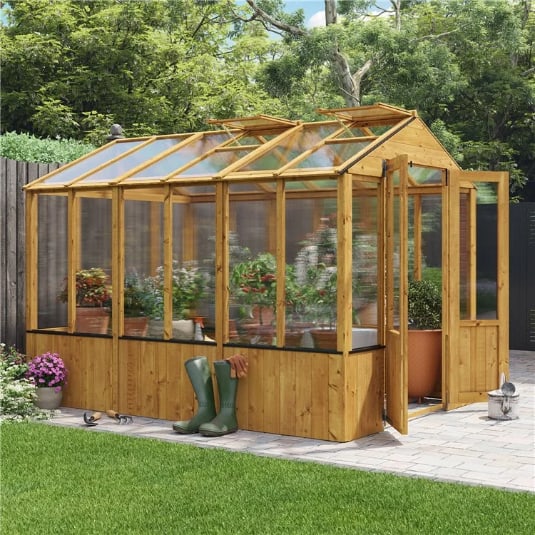Jump to:
Attention, budding green thumbs! It’s never too late to start your greenhouse gardening journey, and we’re here to help. This guide covers what you need to do to set it up for a productive season—something even seasoned gardeners will attest to!
Where You Put Your Greenhouse Matters

The ideal greenhouse layout is in a spot that gets plenty of sunlight, has good drainage and easy access, and is protected from strong winds.
Sunlight is essential for plant life. Even though they’re sheltered inside a greenhouse, these greens still need it for photosynthesis, and where you place it makes a difference
How much they need depends on the type of plant. For full-sun plants like tomatoes and peppers, at least 6–8 hours of direct sunlight per day is best. Meanwhile, certain herbs and leafy greens can manage with as little as 4–6 hours. Garden plants that grow in the shade can thrive with minimal exposure, around 2–4 hours a day.
A location near a fence or tree line is worth considering, too. Such barriers can act as natural windbreaks, but make sure they don’t cast too much shade over the greenhouse.
Good drainage is a given, as with most garden structures, to prevent waterlogging. As for accessibility, the greenhouse should be easy to reach from all sides for maintenance, repairs, and whatever else you need to do.
To learn more, read this guide: How Much Sunlight Does a Garden Greenhouse Need?
Don’t Forget the Base

Greenhouses need a level and stable base for stability, durability, and structural integrity. Remember, the stronger your greenhouse, the better it protects your plants long-term.
When it comes to the base, you’ve got a few options. A concrete slab is a crushed stone material poured directly onto the ground. Once hardened, this layer acts as support between the existing soil and the slab itself.
Paving stones are a mix of gravel, sand, and sometimes finer crushed stones. This mixture is compacted to create a level and stable surface.
Alternatively, you can opt for a quick-fit base kit. It’s a ready-to-use foundation system that, once placed on the ground and interlocked, forms a solid, level surface for your greenhouse to sit on. A great example is the Ecobase Fastfit Foundation Base, which requires no assembly service.
Invest in Additional Equipment for Temperature Control

A greenhouse alone won’t be enough to maintain the ideal environment for plants—you’ll have to do your part as well. And by this, we mean spending a bit extra, which can help save you more in the long run.
Thermostats and heaters, for one, can be costly, but they’re useful for monitoring and controlling the temperature inside. The same goes for shade cloths, cooling systems, and insulation, which help during the warmer months. These solutions help keep your plants healthy, so you won’t have to keep replacing ones that don’t make it.
Ventilation is equally important. Most greenhouses are designed with built-in vents, so take advantage of these features if yours has them. If this isn’t an option, install a few fans to circulate air and prevent hot or cold spots year-round. Or you can simply open the doors if conditions aren’t too harsh.
Work with Lighting to Improve Greenhouse Growing
There are instances where a good spot that meets all the requirements we listed above just doesn’t exist, or it’s not practical to use. In that case, you’ll need to make adjustments to make it work, and adding artificial lighting is the best way to do this.
High-intensity discharge (HID) lamps are the most common type of artificial lighting used in greenhouses. They produce a high-intensity light that’s well-suited for stimulating plant growth. LEDs are also great, as they can be adjusted to match the light needs of different plant species.
The amount of light needed varies by plant species and growth stage.
Watering and Humidity Management
Irrigation is a common greenhouse system that delivers water directly to the root zone of plants. There are different methods, including:
- Drip irrigation: Delivers water straight to the base of each plant, minimising waste and reducing the risk of leaf diseases.
- Overhead sprinklers: Suitable for larger greenhouses, providing even coverage but potentially raising humidity levels.
- Capillary mats: Ideal for seedlings, as they distribute moisture from below, encouraging strong root growth.
If you’re on a budget, you can set up a DIY drip system using a hose with small holes drilled in it.
For humidity control, use a hygrometer to monitor levels inside. Dehumidifiers or misters can help adjust humidity, keeping it in the ideal range (typically 50–70%) for healthy plant growth.
Careful Plant Spacing
Make sure your plants have enough space in the greenhouse to keep them healthy. Otherwise, they’ll end up competing for light, air, and nutrients, which can slow their growth and make them more prone to disease.
Good spacing also improves air circulation, helps keep pests and mould under control, and gives each plant the best chance to grow well. To make the most of your space, consider the following:
- Vertical gardening: Maximises space by using shelves, hanging baskets, or trellises with planter boxes for climbers.
- Rotating layout: Arrange plants based on their growth stages and sunlight needs. Keep taller plants at the back or sides to avoid shading smaller ones.
- Companion planting: Group compatible plants together to support growth and help with pest control.
In the end, that means healthier plants and better results for you.
And that’s it for our greenhouse setup guide! These are just some of the ways you can set up your greenhouse and get off to a great start. If your garden space allows it, you might as well add a small potting shed to keep your essentials in one place.
Not bought a greenhouse yet? Check out our greenhouse buying guide for all the advice you need.
For maintenance, give this guide a read next: Garden Greenhouse Cleaning Guide










